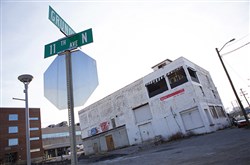VOL. 40 | NO. 4 | Friday, January 22, 2016
Gulch North transforming from gritty to golden
By Kathy Carlson
On a gray January day inside one of Nashville’s best-known music venues, 12th & Porter, the sound track includes the whine of a drill and the rough rip of box cutters, the voices of a work crew and the occasional ring of a cell phone.
Up the street, a flatbed truck rumbles and threads its way through a narrow intersection. Work hums along on a new corporate landmark for HCA and hundreds of apartments.
It’s the music of the north end of The Gulch – the part between Broadway and Charlotte, the interstate and the railroad tracks. Once the ugly stepsibling of the original Gulch that sprang up south of Broadway, the north end is being transformed amid one of Nashville’s biggest growth spurts.
“This part of The Gulch is going to look totally different in two years,” says Nashville native Nathaniel Beaver, co-owner with executive chef Tabor Luckey of Infinity Hospitality Group, the parent of 12th & Porter.
Beaver points toward 12th and Broadway, where a mixed-use development is planned for what used to be a car dealership. He mentions the apartments going up, the talk of more to come. “In two years it will be what The (original) Gulch is now.”
The north end of The Gulch has made the list of prime developable property in Nashville, which includes “any area within the urban core in close proximity to downtown,” says Mark Bloom, Nashville real estate investor. “… There’s a huge tsunami of outside investment capital that’s willing to be put to work in Nashville.”

Stone
The area is coming into its own for both residential and commercial development, adds Hagan Stone, a Nashville Realtor and past president of the Greater Nashville Association of Realtors.
In past years, this part of The Gulch “was just unattractive,” Stone says. “We used to go there in college, to Café 123, 12th & Porter. That felt edgy; now that doesn’t feel edgy at all.”
Former Nashville restaurateur and now attorney, Jody Faison, was there in the early days.
In 1984, he opened 12th & Porter in a cinderblock building that previously housed an unpretentious beer-and-burger place called Fergy’s. An automobile body shop operated next door.
“The building was so funky,” Faison says of 12th & Porter. “The contrast was a lot of the appeal. It was just a different world. … We never really gentrified over there.”
Twelfth & Porter offered both food and music. As a restaurant, it specialized in quirky, but tasty dishes like Pasta YaYa, chicken and pasta with a Cajun touch. Twelfth & Porter became known as a place where top-notch national artists like the legendary late songwriter Townes Van Zandt played and where other musicians started out.
Beaver, part of the new 12th & Porter team, also dropped in for concerts at the old venue and is thrilled to be bringing it back. Its grand reopening is Feb. 5.
Inside, 12th & Porter sports a warm, caramel-colored concrete floor, dark walls and dark woods. The restaurant area’s original metal tile ceilings remain, painted gray. Chunky custom-made wood tables beckon guests into the dining area, which contains a small stage. On the other side of the building and down a few steps is a main stage that will accommodate more than 300.
It’s going to be the only place downtown serving a full menu until 3 a.m., Beaver adds.
The menu will include the restaurant’s own made-from-scratch barbecue, from-scratch ice cream sandwiches and an adult root beer float. Going for bar food with a Nashville-Southern-culinary twist.
“We want it to be comfortable for everyone,” says Colleen Callahan, 12th & Porter manager and Connecticut transplant
“We definitely want to cater to the locals, people in the music industry, the bar and restaurant industry, people who are playing downtown. When they get off, they can come here.”
As a matter of fact, the north end of the Gulch’s location is a pretty sweet spot.
Stone and Metro Councilman Freddie O’Connell, who represents the area, say this part of The Gulch is a natural connector between the original Gulch development, downtown Nashville and attractions just to the north such as First Tennessee Park, the new home of Nashville’s minor league baseball team, the Sounds.
The area is growing because the original Gulch ran out of space, explains Tom Frye, an independent real estate broker with Baker Storey McDonald Properties. He’s been in Nashville real estate since 1988 and has watched the area take shape.
Official terminology
Metro Nashville’s Planning Department, in its Nashville Next plan for growth through 2040, considers downtown to cover more than 1,700 acres bounded the inner loop of interstate highways.
It includes both sides of the Cumberland River, Capitol Hill, Nissan Stadium, the Farmers Market, Music City Center, Bridgestone Arena and the Davidson County Courthouse.
It also includes the area popularly known as The Gulch, which Planning calls Gulch South and defines to include everything from the buildings fronting on the north side of Charlotte – such as the HCA project – to the railroad tracks on the east and the interstate loop on the north and west. The southern portion of the South Gulch was the first to be developed, and now includes high-rise residential, shopping and dining.
The Planning Department’s official Gulch North extends northward from behind the buildings fronting on the north side of Charlotte to Herman Street, and from the interstate loop on the west to Rosa Parks Boulevard and the railroad tracks on the east.
— Kathy Carlson
The original Gulch developed first, he says, because of existing traffic and travel patterns. There was much more traffic on 8th and 12th Avenues South and all of that poured into the South Gulch.
The only well-traveled road into the northern part of The Gulch was Charlotte, and Charlotte did not carry much business or tourist-related traffic.
“That’s what kept the north at bay,” Frye notes.
“Tourists don’t go to the northern part of the business district because that’s where the government is. It’s natural that the northern part of the business district didn’t develop like the south did.”
But two downtown projects helped nudge new development north, he says.
The first was the renovation of the Davidson County Courthouse in 2003 and creation of Public Square Park the following year.
Then came construction of First Tennessee Park, which opened last spring. Both projects have boosted development north of Broadway in downtown, including the northern part of The Gulch.
Development is radiating outward from downtown, with prime development areas extending to The Gulch.
Prices have gone north of $250 per square foot, says investor Bloom. That’s a big leap from the $35-40 per square foot rate during the Great Recession of 2008-09.

1101 Grundy Street is the site for 26,000-square-foot office/retail building. Gulch Grundy Partners LLC is the developer.
-- Michelle Morrow | The Ledger“After 2011-2012 there was just a massive increase in the prices of developable land, and the choicer spots can go for $250 per square foot. … I haven’t seen this sort of run-up in this city,” Bloom said in an interview last July.
This month, he notes that prices were trending higher by 20% in the last 6 months in prime areas.
For example, LifeWay Christian Resources sold its nearly 15 acres of property just east of The Gulch off 9th Avenue North sold in November for $125 million cash, Middle Tennessee’s largest commercial real estate transaction of the year. That works out to more than $191 per square foot.
Mixed-use development is on tap for that tract, although developers’ representatives declined to offer more specifics.
Developers of the 32-acre Capitol View site north of Charlotte began assembling land for the project some seven or eight years ago, says Jeff Haynes of Boyle Nashville LLC.
The site, under development by Boyle and Northwestern Mutual, includes 10 acres on which HCA is building headquarters for its Parallon Business Solutions and Sarah Cannon Research Institute.
Just east of the HCA property, Boyle and Northwest Mutual are developing another 10 acres in mixed-use structures that will provide office space, retail, a hotel, parking and apartments.
“Northwestern Mutual and Boyle both believe in the urban revitalization going on all around the country. Certainly, with all the residential development all over town, millennials, retirees and others want to experience urban revitalization,” Haynes explains.
“Having 32 contiguous acres – a large tract – allows Boyle and Northwest Mutual to develop one complete, cohesive project under a single master plan.”
Interestingly, downtown residents are pretty evenly split between Millennials, Gen Xers and members of the baby boom generation, says Tamara Dickson, vice president, economic development with the Nashville Downtown Partnership.
The partnership released its annual report on downtown population and residential construction last July. Two weeks later, she adds, it needed to be updated after additional plans for residential construction were announced.
So what does all of the growth mean?
“Just about every private capital investment on the scale of what’s being proposed in the urban core right now stands to offer a significant return to the city across a variety of possible revenue streams (property, sales, hotel/motel, etc.),” Council member O’Connell says.
“But we can’t ignore the fact that we have to continue to invest in public services and infrastructure with some of that return. I can’t give you an estimate on the dollar impact, but I suspect it’s considerable, especially with a lot of the acreage of The North Gulch previously undeveloped.”
“Any progressive city that is enormously successful in attracting people will have infrastructure issues that need to be addressed (such as) congestion and traffic,” Bloom says.
“Any city that is successful in attracting new citizens and new businesses and new corporations is going to have those types of problems. … We’re expecting a million more residents in the next 25-30 years. The city will become denser and more vertical in the urban core” and these neighborhoods need to be walkable.
The cost of living in the urban core will be dramatically higher than it used to be, Bloom adds.
The construction boom appears to be sustainable as long as there’s not a macro event that affects the equity market or raises interest rates, Bloom adds.
Macro events – such as a drastic downturn in equity markets or deflation talk amid significant moves down in price for oil, commodities, natural resources – can affect real estate investment and values and stifle development, he explains.
Frye started his real estate career in the 1970s and has witnessed five major recessions, each for a different reason. One business cycle ends and then another starts up again, he says.
One thing is for sure: The interest in Nashville is real, Bloom says.
There’s a “difference in the perception of Nashville and what it’s going to become.”